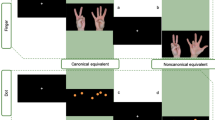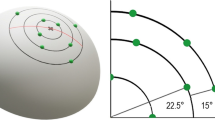Abstract
Finger counting is one of the first steps in the development of mature number concepts. With a one-to-one correspondence of fingers to numbers in Western finger counting, fingers hold two numerical meanings: one is based on the number of fingers raised and the second is based on their ordinal position within the habitual finger counting sequence. This study investigated how these two numerical meanings of fingers are intertwined with numerical cognition in adults. Participants received tactile stimulation on their fingertips of one hand and named either the number of fingers stimulated (2, 3, or 4 fingers; Experiment 1) or the number of stimulations on one fingertip (2, 3, or 4 stimulations; Experiment 2). Responses were faster and more accurate when the set of stimulated fingers corresponded to finger counting habits (Experiment 1) and when the number of stimulations matched the ordinal position of the stimulated finger (Experiment 2). These results show that tactile numerosity perception is affected by individual finger counting habits and that those habits give numerical meaning to single fingers.






Similar content being viewed by others
Notes
All individual stimulation durations range from 47 to 180 ms and all total stimulation durations range from 260 to 640 ms. Although participants might learn that 47 ms could never involve two stimulations, we chose not to use the shortest individual stimulation length for two stimulations, because that would have resulted in a very short (154 ms) total stimulation length which would have given away the numerosity without requiring actually counting the number of individual stimulations. Furthermore, additional analyses showed that there was no training effect selectively for stimulation conditions involving 47 ms-stimulations.
To keep the size of the model reasonable, only factors of theoretical interest were modeled. For instance, the factor Hand (left/right) was not included. Moreover, including Hand as a fixed factor would not bring about any significant main effects or interactions in the complete models except for a three-way interaction of DC × Hand × NUM in the sequential condition.
The index finger of the opposite hand was always the responding finger, so one could expect interactions with stimulations to the index finger. We therefore coded a new factor “Response Finger” (i.e., index finger or not) and ran the (generalized) linear mixed models with the fixed factors Congruency, Response Finger, and their interaction and as random factors Subject, Response condition, and Stimulation pattern and with the random slopes determined as described above; there were no random slopes for the RT analysis and by-subject random slopes for Congruency and Response Finger as well as by-pattern random slopes for Congruency for the accuracy analysis. There were no significant interactions between Congruency and Response Finger for RTs or accuracy.
References
Baayen, R. H. (2008). Analyzing linguistic data: A practical introduction to statistics. Cambridge: Cambridge University Press.
Bates, D., Maechler, M., Bolker, B., & Walker, S. (2015). Fitting linear mixed-effects models using lme4. Journal of Statistical Software, 67(1), 1–48. https://doi.org/10.18637/jss.v067.i01.
Bender, A., & Beller, S. (2012). Nature and culture of finger counting: Diversity and representational effects of an embodied cognitive tool. Cognition, 124(2), 156–182. https://doi.org/10.1016/j.cognition.2012.05.005.
Bender, L. (Producer), & Tarantino, Q. (Director). (2009). Inglorious Basterds [Motion Picture]. United States: Universal Pictures.
Brozzoli, C., Ishihara, M., Göbel, S. M., Salemme, R., Rossetti, Y., & Farnè, A. (2008). Touch perception reveals the dominance of spatial over digital representation of numbers. Proceedings of the National Academy of Sciences of the United States of America, 105(14), 5644–5648.
Casasanto, D. (2009). Embodiment of abstract concepts: Good and bad in right- and left-handers. Journal of Experimental Psychology: General, 138(3), 351–367. https://doi.org/10.1037/a0015854.
Cohen, Z. Z., Aisenberg, D., & Henik, A. (2016). The effects of training on tactile enumeration. Psychological Research. Advance Online Publication. https://doi.org/10.1007/s00426-016-0835-5.
Cohen, Z. Z., & Henik, A. (2016). Effects of numerosity range on tactile and visual enumeration. Perception, 45(1–2), 83–98. https://doi.org/10.1177/0301006615614662.
Cohen, Z. Z., Naparstek, S., & Henik, A. (2014). Tactile enumeration of small quantities using one hand. Acta Psychologica, 150, 26–34. https://doi.org/10.1016/j.actpsy.2014.03.011.
Coolidge, F. L., & Overmann, K. A. (2012). Numerosity, abstraction, and the emergence of symbolic thinking. Current Anthropology 53(2), 204–225. https://doi.org/10.1086/664818.
Cousineau, D. (2005). Confidence intervals in within-subject designs: A simpler solution to Loftus and Masson’s method. Tutorials in Quantitative Methods for Psychology, 1(1), 42–45.
Dehaene, S., Bossini, S., & Giraux, P. (1993). The mental representation of parity and number magnitude. Journal of Experimental Psychology: General, 122(3), 371–396.
Di Luca, S., Granà, A., Semenza, C., Seron, X., & Pesenti, M. (2006). Finger-digit compatibility in Arabic numeral processing. Quarterly Journal of Experimental Psychology, 59(9), 1648–1663. https://doi.org/10.1080/17470210500256839.
Di Luca, S., & Pesenti, M. (2008). Masked priming effect with canonical finger numeral configurations. Experimental Brain Research, 185(1), 27–39. https://doi.org/10.1007/s00221-007-1132-8.
Di Luca, S., & Pesenti, M. (2011). Finger numeral representations: More than just another symbolic code. Frontiers in Psychology, 2, 272. https://doi.org/10.3389/fpsyg.2011.00272.
Domahs, F., Kaufmann, L., & Fischer, M. H. (Eds.) (2012). Handy numbers: Finger counting and numerical cognition. Lausanne: Frontiers Media SA.
Domahs, F., Moeller, K., Huber, S., Willmes, K., & Nuerk, H.-C. (2010). Embodied numerosity: Implicit hand-based representations influence symbolic number processing across cultures. Cognition, 116(2), 251–266. https://doi.org/10.1016/j.cognition.2010.05.007.
Elbert, T., Pantev, C., Wienbruch, C., Rockstroh, B., & Taub, E. (1995). Increased cortical representation of the fingers of the left hand in string players. Science, 270, 305–307.
Fischer, M. H., & Brugger, P. (2011). When digits help digits: Spatial-numerical associations point to finger counting as prime example of embodied cognition. Frontiers in Psychology, 2, 260. https://doi.org/10.3389/fpsyg.2011.00260.
Franconeri, S. L., & Simons, D. J. (2003). Moving and looming stimuli capture attention. Perception & Psychophysics, 65(7), 999–1010. https://doi.org/10.3758/BF03194829.
Gallace, A., Tan, H. Z., & Spence, C. (2008). Can tactile stimuli be subitised? An unresolved controversy within the literature on numerosity judgments. Perception, 37(5), 782–800. https://doi.org/10.1068/p5767.
Imbo, I., Vandierendonck, A., & Fias, W. (2011). Passive hand movements disrupt adults’ counting strategies. Frontiers in Psychology, 2, 201. https://doi.org/10.3389/fpsyg.2011.00201.
Kliegl, R., Masson, M. E. J., & Richter, E. M. (2010). A linear mixed model analysis of masked repetition priming. Visual Cognition, 18(5), 655–681. https://doi.org/10.1080/13506280902986058.
Krause, F., Bekkering, H., & Lindemann, O. (2013). A feeling for numbers: Shared metric for symbolic and tactile numerosities. Frontiers in Psychology, 4, 7. https://doi.org/10.3389/fpsyg.2013.00007.
Lindemann, O., Alipour, A., & Fischer, M. H. (2011). Finger counting habits in Middle Eastern and Western individuals: An online survey. Journal of Cross-Cultural Psychology, 42(4), 566–578. https://doi.org/10.1177/0022022111406254.
Lucidi, A., & Thevenot, C. (2014). Do not count on me to imagine how I act: Behavior contradicts questionnaire responses in the assessment of finger counting habits. Behavior Research Methods, 46(4), 1079–1087. https://doi.org/10.3758/s13428-014-0447-1.
McCarthy, L., & Olsen, K. N. (2017). A “looming bias” in spatial hearing? Effects of acoustic intensity and spectrum on categorical sound source localization. Attention, Perception & Psychophysics, 79(1), 352–362. https://doi.org/10.3758/s13414-016-1201-9.
Michaux, N., Masson, N., Pesenti, M., & Andres, M. (2013). Selective interference of finger movements on basic addition and subtraction problem solving. Experimental Psychology, 60(3), 197–205. https://doi.org/10.1027/1618-3169/a000188.
Moher, J., Sit, J., & Song, J. -H. (2015). Goal-directed action is automatically biased towards looming motion. Vision Research, 113(Pt B), 188–197. https://doi.org/10.1016/j.visres.2014.08.005.
Morrissey, K. R., Liu, M., Kang, J., Hallett, D., & Wang, Q. (2016). Cross-cultural and intra-cultural differences in finger-counting habits and number magnitude processing: Embodied numerosity in Canadian and Chinese university students. Journal of Numerical Cognition, 2(1), 1–19. https://doi.org/10.5964/jnc.v2i1.14.
Moyer, R. S., & Landauer, T. K. (1967). Time required for judgements of numerical inequality. Nature, 215, 1519–1520.
Pika, S., Nicoladis, E., & Marentette, P. (2009). How to order a beer: Cultural differences in the use of conventional gestures for numbers. Journal of Cross-Cultural Psychology, 40(1), 70–80. https://doi.org/10.1177/0022022108326197.
R Core Team. (2016). R: A language and environment for statistical computing. Vienna: R Foundation for Statistical Computing. http://www.R-project.org/.
Riello, M., & Rusconi, E. (2011). Unimanual SNARC effect: Hand matters. Frontiers in Psychology, 2, 372. https://doi.org/10.3389/fpsyg.2011.00372.
Rinaldi, L., Gallucci, M., & Girelli, L. (2016). Spatial-numerical consistency impacts on preschoolers’ numerical representation: Children can count on both peripersonal and personal space. Cognitive Development, 37, 9–17. https://doi.org/10.1016/j.cogdev.2015.10.006.
Sixtus, E., Fischer, M. H., & Lindemann, O. (2017). Finger posing primes number comprehension. Cognitive Processing, 18(3), 237–248. https://doi.org/10.1007/s10339-017-0804-y.
Takeuchi, T. (1997). Visual search of expansion and contraction. Vision Research, 37(15), 2083–2090. https://doi.org/10.1016/S0042-6989(96)00225-8.
van Ede, F., Jensen, O., & Maris, E. (2010). Tactile expectation modulates pre-stimulus beta-band oscillations in human sensorimotor cortex. NeuroImage, 51(2), 867–876. https://doi.org/10.1016/j.neuroimage.2010.02.053.
Acknowledgements
This research was supported by DFG (Deutsche Forschungsgemeinschaft) Grant Fi-1915/2 - 1 “manumerical cognition”.
Funding
This study was funded by DFG (Grant number Fi-1915/2 - 1 on “manumerical cognition”).
Author information
Authors and Affiliations
Corresponding author
Ethics declarations
Conflict of interest
All authors declare that they have no conflict of interest.
Ethical approval
All experiments of the study were conducted in accordance with the ethical standards expressed in the Declaration of Helsinki.
Informed consent
Informed consent was obtained from all individual participants included in the study.
Appendix
Rights and permissions
About this article
Cite this article
Sixtus, E., Lindemann, O. & Fischer, M.H. Stimulating numbers: signatures of finger counting in numerosity processing. Psychological Research 84, 152–167 (2020). https://doi.org/10.1007/s00426-018-0982-y
Received:
Accepted:
Published:
Issue Date:
DOI: https://doi.org/10.1007/s00426-018-0982-y




